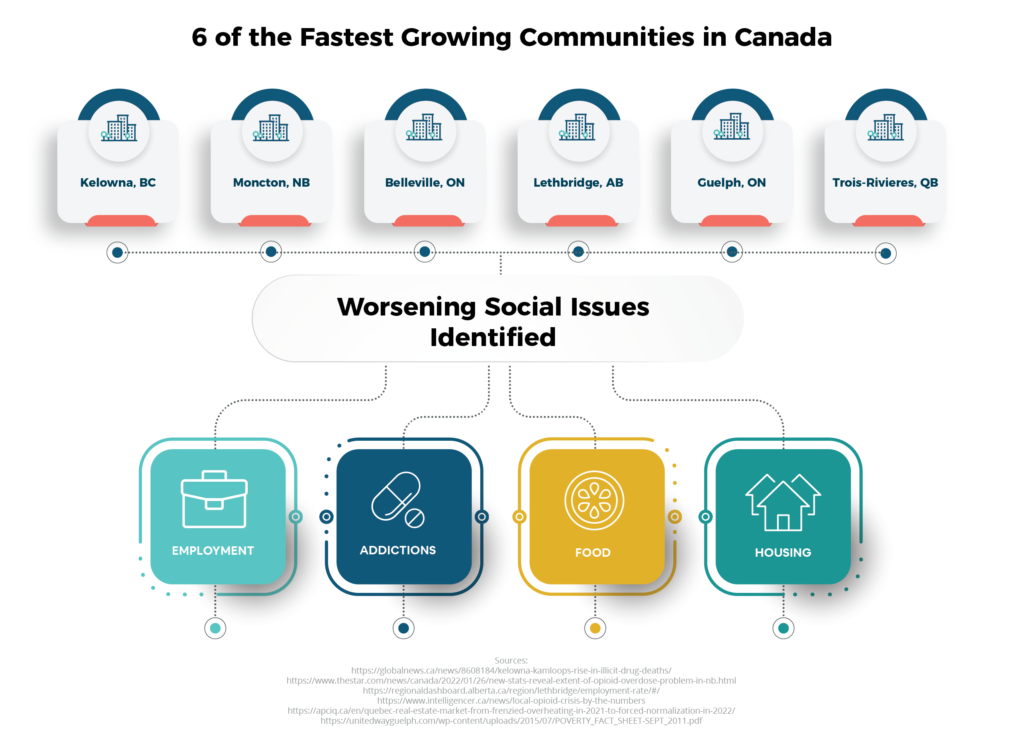For more than a century, urban centres across Canada have experienced rapid growth in population as people move from rural to urban settings, and people from around the world immigrate to our major cities and mid-sized communities. Felt across the country, this population explosion continues today. From 2016 to 2021, the overwhelming majority of Canada’s population growth was seen in urban centres with a population of 100,000 people or more.

But as populations grow, have all (or even most) cities grown their social infrastructure to meet the needs of an expanding populace with ever-changing needs? The answer is a definite no – as evidenced by increasing social challenges including the opioid epidemic, the housing crisis, and other worsening social issues.

With billions of dollars in funding funnelling into the social sector and with hundreds of thousands of services, programs and supports across Canada, why do social challenges increase as populations grow? There are a number of factors, including a misalignment of supply and demand. And of course, the COVID-19 pandemic has exacerbated challenges of all kinds for communities across Canada.
But one thing has become evident, cities need a flexible, adaptable framework for their social safety net in order to shift to meet the ever-changing needs of their ever-changing demographics. Because the larger your city becomes, the more apparent the social challenges you face will become. What was once an issue that municipalities left to other orders of government with mandates for social issues, has suddenly become a pressing challenge demanding immediate attention (and has already garnered the attention of the media and community members).
As a city grows, that municipality naturally grows its consumer base for new businesses, attracts new businesses, and sees its economy diversify. But the social infrastructure – the social safety net – demands attention, analysis and realignment for any city to thrive in the future.
What Challenges & Opportunities Emerge as Cities Expand?
Most cities have developed a robust 10- and 20-year plan for their infrastructure – roads, transit, land use development, and environmental planning. But just as physical infrastructure needs change, so too do social infrastructure needs.
There is growing pressure for municipalities to support community wellbeing and safety, rather than leaving it to provincial governments that have historically held the mandate for social spending on issues such as homelessness and mental health treatment.
Shifting local mandates have been accelerated by the Government of Ontario’s move to require Community Safety and Wellbeing Plans that bring together everyone from the police and city council, to local organizations and community members to create a framework for making their city safer and healthier. While Community Safety and Wellbeing Plans are a promising first step in the integration of social infrastructure at a local level, municipalities building new social mandates — social policy, planning capacity, data collection — are left to make sense of the often complex pre-existing infrastructure, in order to move towards integration.
It’s clear cities need an integrated, whole-community approach to addressing social challenges, one that involves stakeholders at every level (from government right down to the grassroots workers on the ground). This leaves rapidly growing communities asking themselves, where do we start?
Start With What You Have
Municipalities need to bring visibility to the social infrastructure assets that already exist in their communities. Everything from the social service supports for individual and community safety and wellbeing, to staff and volunteers, to capital and financial investments must be counted and evaluated.
From there, cities should be asking themselves how those existing assets can be adjusted to better meet the needs of the community. Due to the challenges brought on by the COVID-19 pandemic, social needs are changing at a rapid pace in cities across Canada. Is your community equipped to gauge those needs and adjust your social infrastructure to address them in the short and long term?
In short, can your community keep up?
It’s likely there are support types that you need more of, including housing and addictions treatment. And, there are likely supports that are no longer serving the need they were designed for — such as overlapping and reactive basic needs services — and need recalibration in order to properly create positive impacts in the community.
Once there is visibility into the social infrastructure, and you’ve compared it against community needs, who needs to be at the table to bring forward sustainable social investment models that will measurably improve community wellbeing outcomes? Addressing existing funding flows and seeking new sources of funding is the next step. But it requires municipalities to examine the money coming in from all levels of government, as well as systems players, community funders, individual donors and private funders. At HelpSeeker, we call this ‘following the money,” and we’ve followed $308 billion of it across Canada.
It’s a complex undertaking, one that’s easy to mismanage, but this will allow for the development of a comprehensive funding strategy to create integrated investment frameworks that ensure the most pressing needs are met in your community, now and in the future.
In the end, municipalities that plan ahead will in turn get ahead. You already know your community will grow, but will it grow in a sustainable, equitable way? By addressing your social infrastructure plan now, your city will be properly equipped to satisfy the wellbeing and safety needs of your diverse, expanding community.
But the most important question to ask yourself is, what are you doing to build a social infrastructure that meets the individual and community wellbeing needs of tomorrow?



